Travel Guide, Ha Giang Loop
Discovering the Golden Beauty of Ha Giang Rice Fields
Embark on a journey to the heart of Vietnam’s northern mountains and discover the mesmerizing beauty of Ha Giang rice fields. This region, renowned for its breathtaking landscapes and rich cultural heritage, offers a unique glimpse into the rural life of Vietnam. The terraced rice fields of Ha Giang, draped in hues of gold during the harvest season, are not just a feast for the eyes but also a testament to the harmonious relationship between nature and the hardworking people who cultivate these lands. In this guide, we’ll explore the various modes of transportation to Ha Giang, the best times to visit, and the most stunning locations to witness the golden rice harvest in all its glory.
Modes of Transportation to Ha Giang
Motorbike
Ha Giang is about 300km from Hanoi, with treacherous roads featuring narrow, winding paths along the mountains, and minimal traffic. Many adventure-seekers prefer motorcycles as their mode of transportation to Ha Giang. However, the weather in Ha Giang during the autumn often includes rain, making mountain roads challenging. If you are not a confident rider, it’s safer to opt for a bus.
Bus
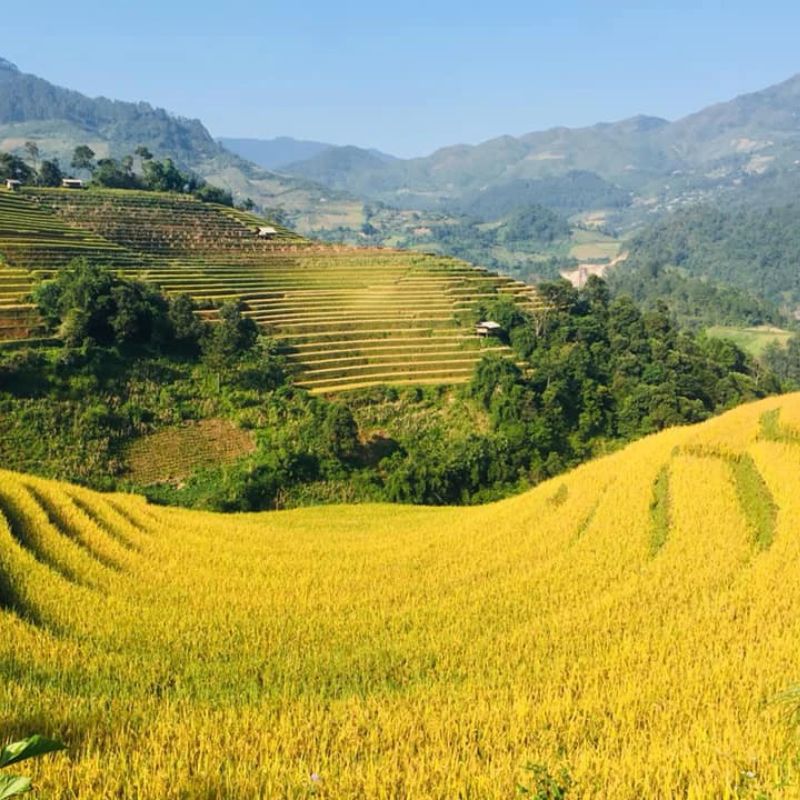
Departing from Hanoi, you can catch a bus to Ha Giang from My Dinh bus station. Ticket prices range from 260,000 – 300,000 VND per person. The journey takes about 8 hours, so many travelers prefer overnight buses to wake up in Ha Giang the next morning.
Airplane
If you’re traveling from Saigon, coordinate your flight to Hanoi (ticket prices range from 650,000 VND – 1,200,000 VND, excluding taxes) with the bus departure times to Ha Giang. The flight takes about 2 hours. Most buses from Hanoi to Ha Giang at night follow the Noi Bai – Lao Cai highway route. It’s advisable to contact the bus company in advance and arrange to be picked up at the junction of Thang Long – Noi Bai expressway and National Highway 2 (about 1km from Noi Bai Airport).
Image | Tour | Price | Quantity | Add to cart |
|---|---|---|---|---|
$ 138 | ||||
$ 172 |
Best Time to Visit Ha Giang During the Rice Harvest
Ha Giang, a famous tourist spot in the Northwestern mountains of Vietnam, is renowned for its rice harvest season. With only one rice crop per year, timing your visit correctly is crucial to witness the endless beauty of golden rice fields on the terraced hills.
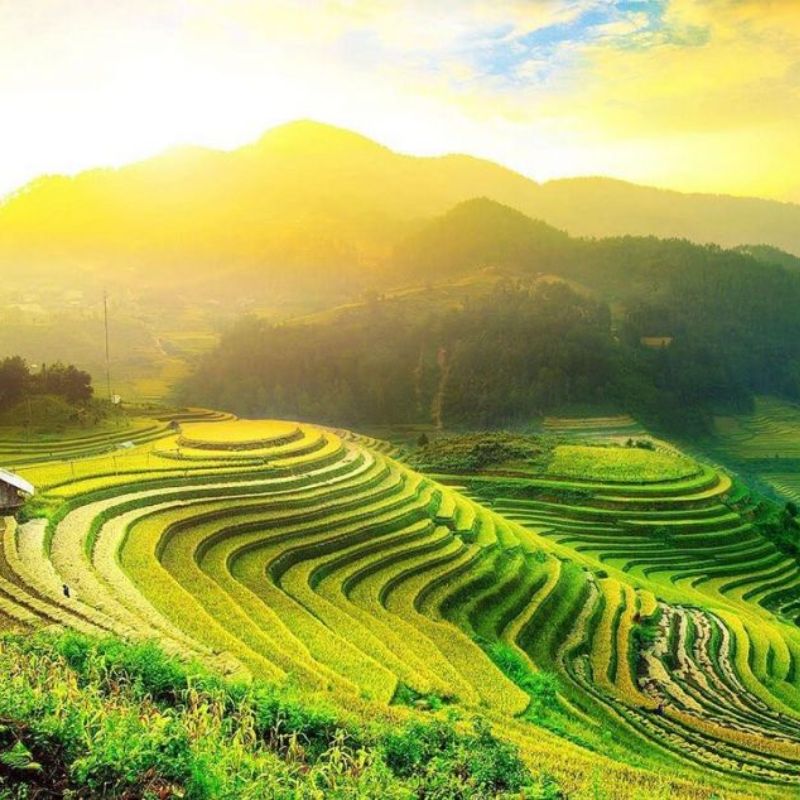
The rice harvest season in Ha Giang typically falls around September to October. The rice ripens gradually over a month, with the most picturesque period usually in the second week of October.
During this time, the weather is mildly cold. Daytime temperatures can reach around 30°C, but at night it can drop to 9-10°C, and occasionally even 4-5°C.
Full Guide Best Time to Visit Ha Giang Loop
Best Places to View Ha Giang Rice Fields
Hoang Su Phi
Hoang Su Phi, a district in the western part of Ha Giang province, is geographically located upstream of the Chay River. The terrain, divided by numerous streams, creates steep slopes.
Thanks to its unique topography, Hoang Su Phi offers panoramic views of layered terraced fields across six communes: Ban Luoc, San Sa Ho, Ban Phung, Ho Thau, Nam Ty, and Thong Nguyen. In 2012, the Ministry of Culture, Sports, and Tourism officially recognized these terraced fields as a National Heritage Site.
Lung Cu Flag Tower
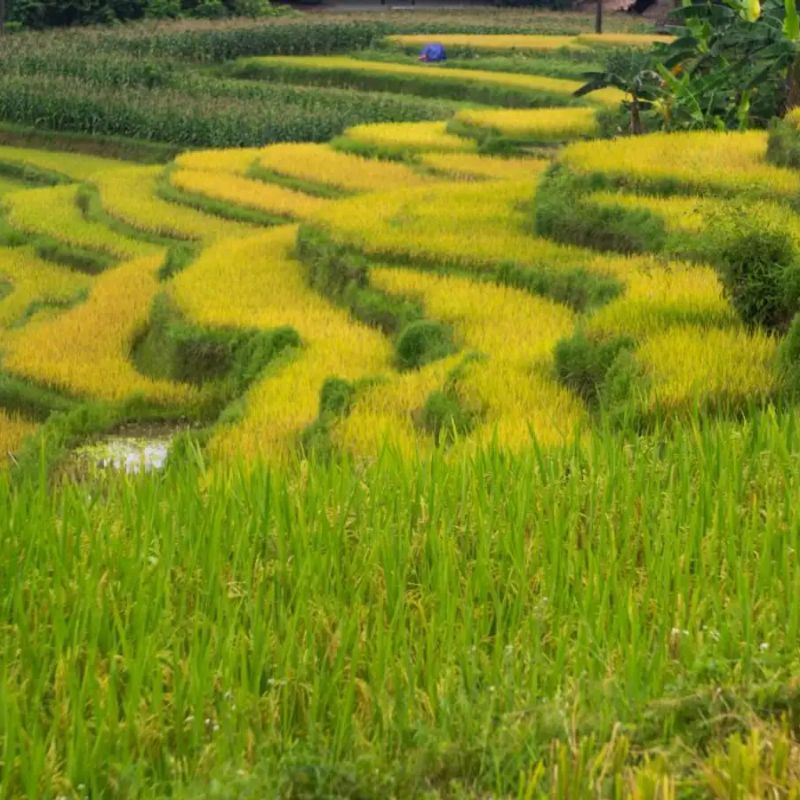
The Lung Cu Flag Tower is a well-known historical site in Vietnam, marking the northernmost point of the country. The flagpole, about 20m high, is located on the Lung Cu peak, the highest point in Northern Vietnam. During the rice harvest season, you can enjoy a panoramic view of Ha Giang’s golden rice fields, blending with the natural beauty of the landscape.
Tay Con Linh Peak
The saying goes, ‘If you go to Ha Giang, you must visit Tay Con Linh Peak’. Not just a high mountain, Tay Con Linh is also known as the ‘roof’ of the Northwestern region of Vietnam, standing at 2419m above sea level. It’s an ideal destination for adventurous and nature-loving youths. Though the journey may be challenging, the satisfaction of conquering Tay Con Linh Peak and witnessing the rice harvest from above is unparalleled.
Ho Thau Terraced Fields (Hồ Thầu)
Originating from the upper tributaries of the Chay and Bac rivers, Ho Thau means ‘source head’. Although not as famous as Ban Luoc and Ban Phung, the beauty of Ho Thau is unique and comforting. The area is also known for the Chiêu Lầu Thi mountain, the second-highest peak in Ha Giang.
Ban Phung Terraced Fields (Bản Phùng)
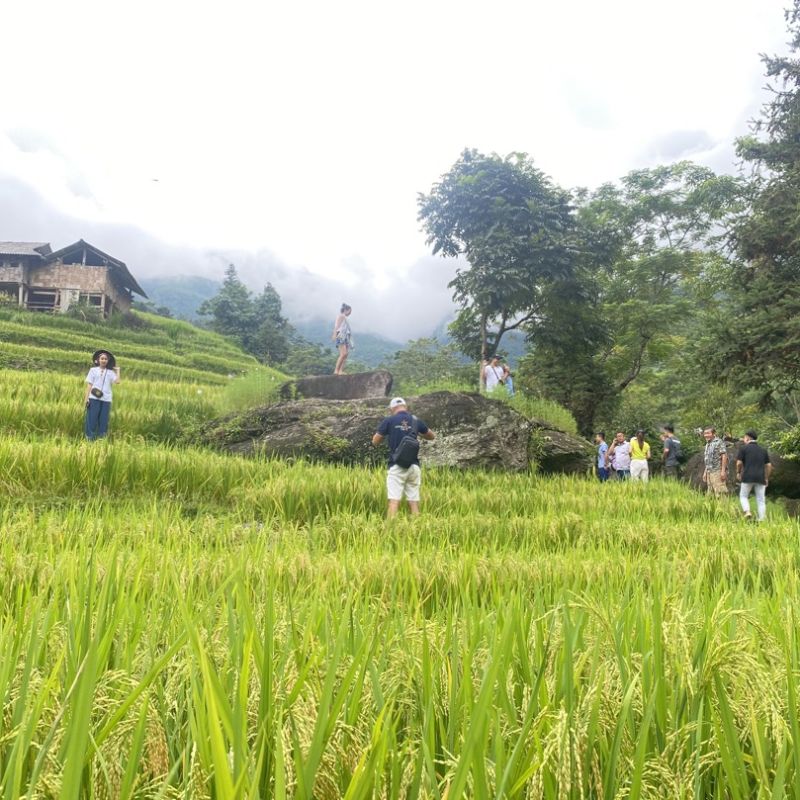
The name ‘Phung’ means ‘encounter’, symbolizing the meeting of heaven and earth amidst stunning natural beauty. Ban Phung is renowned for having some of the most beautiful terraced fields in Hoang Su Phi and Vietnam. The surroundings occasionally feature light clouds, adding a mystical charm to the landscape.
Ban Luoc (Bản Luốc)
A visit to Ha Giang during the rice harvest season is incomplete without seeing Ban Luoc. Known for its breathtaking scenery, the terraced fields here become even more picturesque during the harvest season. From a high viewpoint, you can see the golden rice fields extending to the horizon, offering a perfect photo opportunity.
Tips for Traveling to Ha Giang During the Rice Harvest Season
- When visiting Ha Giang during the rice harvest, don’t miss out on the local specialties such as Thang Co, buckwheat flower cakes, Au Tau porridge, Ha Giang rolled pancakes, smoked buffalo meat, Bac Me sticky rice, etc.
- Remember to carry your ID and wear appropriate clothing for the weather.
- Politeness and cultural sensitivity are important, especially since Ha Giang is home to many ethnic minorities. Respecting their culture is crucial.
As our journey through the golden rice fields of Ha Giang comes to a close, we leave with a deeper appreciation for the stunning beauty and rich cultural tapestry of this unique region in Vietnam. The terraced fields, shimmering in the sun, are more than just picturesque landscapes; they are a symbol of the resilience and dedication of the local communities. Whether you’re an adventure seeker, a nature lover, or a culture enthusiast, Ha Giang rice fields offer a truly unforgettable experience. We hope this guide inspires you to explore the breathtaking beauty of Ha Giang and immerse yourself in the tranquility and tradition of Vietnam’s rural heartland.
FAQs
Can I participate in rice harvesting activities in Ha Giang?
Participating in rice harvesting activities in Ha Giang can be a unique and enriching experience, offering a glimpse into the local agricultural practices and the daily life of the rural communities. While not all areas may permit active participation due to safety and skill requirements, some local farmers and communities welcome tourists to observe and sometimes engage in the rice harvesting process. This typically depends on the time of your visit and the willingness of the local farmers.
Are there any local specialties in Ha Giang I should try?
Absolutely! Ha Giang’s culinary scene is as vibrant and diverse as its landscapes, offering a range of unique local specialties that you must try. One of the most renowned dishes is Thang Co, a traditional stew made from horse meat, a delicacy among the H’mong people. Another must-try is the buckwheat flower cake, made from the region’s iconic buckwheat flowers, offering a unique flavor and texture. Smoked buffalo meat is also a local favorite, known for its rich taste and smoky aroma.
Is a guide necessary for exploring Ha Giang’s rice fields?
While it’s possible to explore Ha Giang rice fields independently, having a local guide can significantly enhance your experience. A guide offers invaluable insights into the local culture, history, and customs, making your journey more enriching. They can navigate the challenging terrain with ease, ensuring your safety, especially on the narrow, winding mountain roads. Additionally, a guide can facilitate interactions with local communities, allowing for a more authentic and respectful engagement. They can also assist with language barriers, making your trip smoother and more enjoyable.
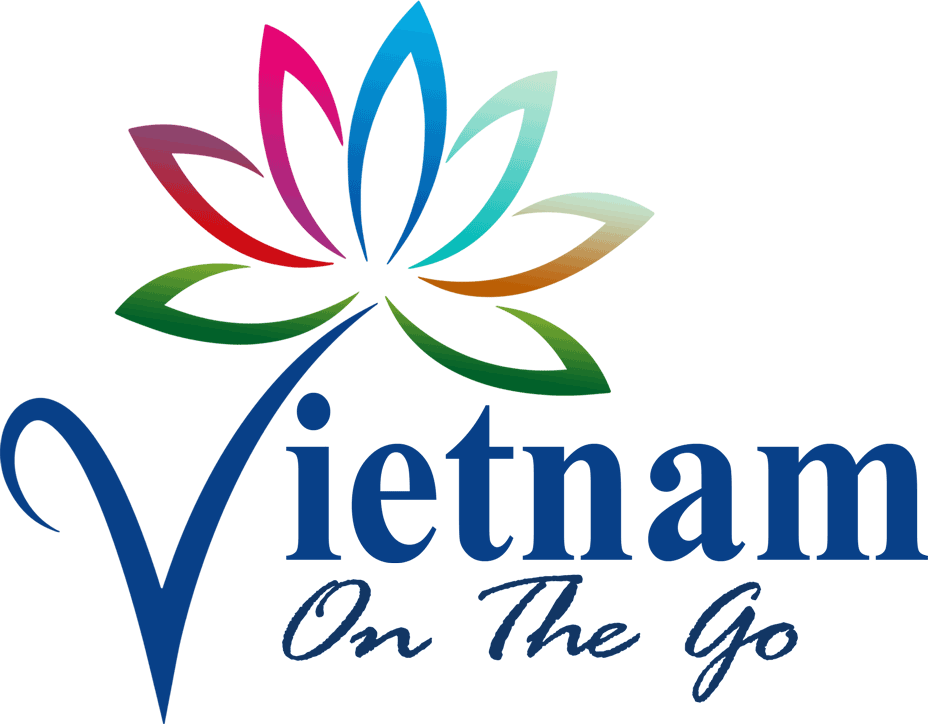
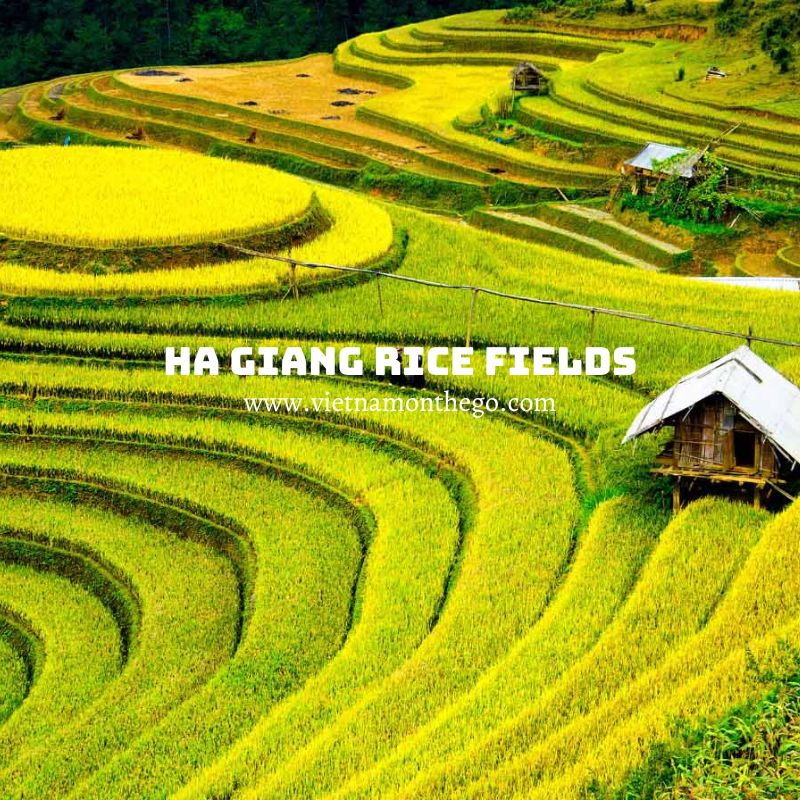
![[3 DAYS 4 NIGHTS] Ha Giang Loop Motorbike Tour from Hanoi](https://vietnamonthego.com/wp-content/uploads/2024/03/ha-giang-loop-tour-6-300x300.jpg)
![[4 DAYS 5 NIGHTS] Ha Giang Loop Motorbike Tour from Hanoi](https://vietnamonthego.com/wp-content/uploads/2024/03/ha-giang-loop-tour-300x300.jpg)